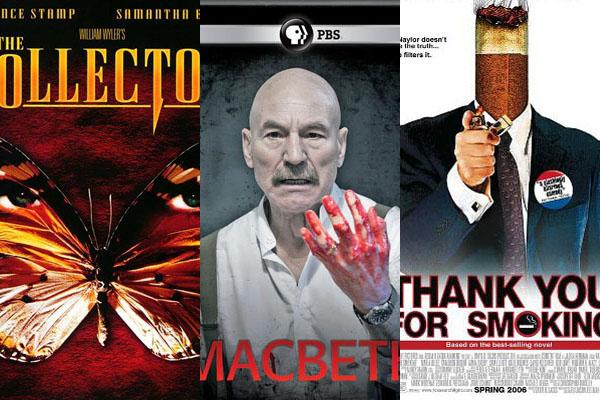Moving from book to big screen
RB curriculum features films which were once novels
March 14, 2014
Lately, every popular book seems to be getting turned into a film. For the most part, people consider film adaptations of popular novels to be lesser than the book, but every once in a while, there comes a film adaptation that’s actually not only good, but possibly better than the original.
Look no further than the RB curriculum, in which students read many books which have been brought to the big screen. The English and Social Studies departments show several films that were once books. Here are some of the titles.
From Book to Film: The Collector
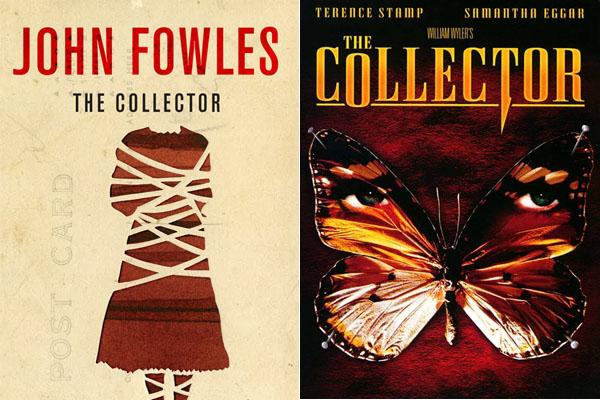
If I were to mention the title The Collector nowadays, you’d probably think of that tremendously stupid, albeit entertaining, horror movie that came out in 2009. What I will be talking about though, is the book written by John Fowles that English Teacher Thomas Fuller teaches in his English Ten and it’s film adaption. The novel follows a lonely man named Frederick Clegg who, upon winning a large sum of money, decides to kidnap a girl named Miranda Grey in an attempt to get her to love him. The novel is a highly intriguing story told from the eyes of both the kidnapper and the captive.
The film adaptation came out in 1965, two years after the novel was published, and starred Terence Stamp, of Superman fame, as Clegg and Samantha Eggar as Miranda. Overall I found it to be an okay film as for the most part, it stayed true to the novel. Some parts were left out and others rearranged, but as that’s common in film adaptions of novels, I feel I should let those few incidents slide. A rather negative aspect of the film that I didn’t enjoy was that while I found Stamp in this movie was for the most part how I pictured Clegg, Eggar’s performance as Miranda came up a bit short. You can’t really bring the characters inside there own heads like in a novel, but still, I found that there was still something that she could have done to really get her character across.
Speaking with Fuller, who has not only read the book over twenty times but has been teaching it for a number of years, he told me his opinion about the film.
“It’s horrible…Fowles wrote the novel with specific literary techniques that the film didn’t have.” He said he found that Stamp did a good job of invoking Clegg’s character but also pointed out he’s not that complicated to play. He also linked that type of role to what Anthony Hopkins did in The Silence of the Lambs, saying that once Hopkins knew how to embody the character, the role that won him an Oscar was really easy.
“A lot of people are lazy…several probably went to see The Hunger Games without reading the book…Divergent is being made into a movie” says Mr. Fuller, although he did add that film adaptions of movies can be positive in the sense that it exposes people to the novel.
“There were probably some people who read Catching Fire in between the gap of the two movies.”
From Book to Film: Of Mice And Men
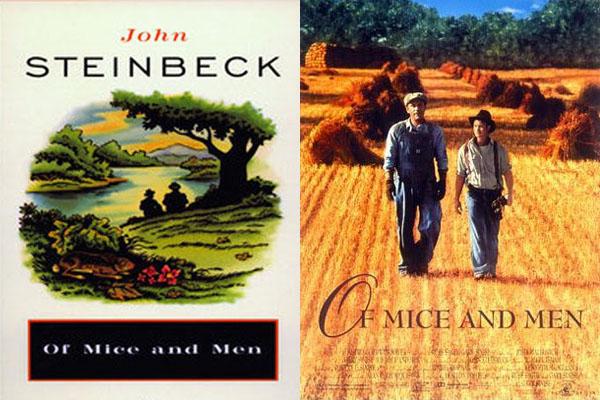
The novella Of Mice And Men by John Steinbeck set during the Great Depression follows the friendship of George Milton and Lennie Small as they dream of one day owning their own ranch. Though, since the title is derived from the line of Robert Burns’ poem ‘To a Mouse’ which reads “The best laid schemes o’ mice an’ men / Gang aft agley” (The best laid schemes of mice and men / Often go awry) you can probably imagine that things don’t exactly go according to plan. This story has been adapted twice for the screen, once in 1939 and again in 1992. For this review I decided to focus on the 1992 version. Since it’s the more recent of the adaptations, it’s probably the one that my peers would choose to watch.
The film was directed by and starred Gary Sinise as George alongside John Malkovich as Lennie. The film was mostly faithful to the novella, with some scenes only slightly altered and some material added, but that was probably done to make a relatively short novella into a full length film. If you read the novella in school I definitely recommend watching this version as I find it definitely captures the feeling of the story and the performances by the two leads is terrific.
I decided to interview English teacher Wendy Cassens about how Of Mice And Men has been a required reading in many schools and has also been a frequent target of censors for vulgarity and what some consider offensive and racist language. It also appears on the American Library Association’s list of the Most Challenged Books of 21st Century.
“I don’t think it should be banned or censored because Steinbeck is trying to show that [George and Lenny are] not treated fairly. He picks the lowest people in society and shows that they should be treated better,” Cassens said.
Cassens also added how she finds that it’s a good story about friendship, which is something that I agree with.
From Book to Film: A Separate Peace
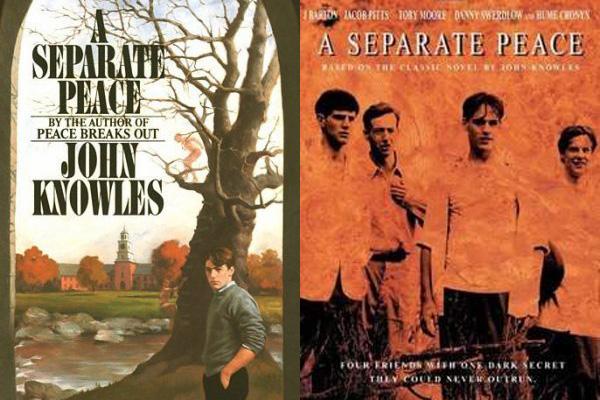
A Separate Peace by John Knowles is a tale about friendship and tragedy. The novel is told from the perspective Gene Forrester about his time at Devon prep school and more specifically the relationship he has with his best friend and sports prodigy Phineas or Phinny for short. And you can probably already guess that it is taught at RB and that there’s a film adaption. Of course there have been two film adaptations, one in 1972 and a another made for television in 2004. I wanted to review specifically the 1972 version since it’s screenplay was by Fred Segal and Knowles but sadly I was unable to find a copy so I instead rented the 2004 version.
The thing with A Separate Peace is it’s a story that requires you to really be inside the main character’s head to understand everything, which is something you can’t do nearly as well in a film. And sadly the fears turned out to be accurate. None of the characters are how I pictured them and the film either omits or does a poor job of adapting several important parts of the novel. What stood out above the rest was this one important scene involving are two main characters and a tree and I really didn’t like how it was depicted.
Before I get into the issue of why this book shouldn’t have been adapted, I felt that I should proably go into why any book is adapted for film.
“Money,” said English teacher Tom Fuller. “If the book is relatively successful and popular film producers know it will also play well.” Fuller noted that directors and producers might always consider whether or not a book can be adapted into film line by line, but ultimately he thought the motivation was financial.
“I find nothing interesting about adapting a book to film. It’s already been created,” he said.
So why would an author like Knowles sign off for a film adaptation and help write the script? You might think the author would know better than anyone that the story really can’t be told through film.
“Why would he sign off? For exposure purposes. It’s a really popular book that’s taught in a lot of schools and a film makes more people aware of that,” Fuller said.
Money and exposure may sound really cynical to some, but to me it sounds like a pretty good explanation.
From Book to Film: Thank You for Smoking
This review is different from the others as it is the first of what hopefully be several reviews of films that are actually shown in Social Studies. The film adaption of Thank You for Smoking by Christopher Buckley is shown by both Jill Musil and John Fields in US Government. The plot follows Nick Naylor, the chief spokesman for the Academy of Tobacco Studies, as it details his life of working at one of the most hated corporations in the world. The novel shows he is able to effectively do his job with quick wit and wordplay and be able to sleep at night due to what he calls the Nuremberg defense: “I vas only paying ze mortgage.”
The film adaption was written and directed by Jason Reitman, who would later go on to direct Juno and Up in the Air, and starred Aaron Eckhart as Naylor who several may recognize as Harvey Dent/Two-Face from The Dark Knight. The film for the most part matches the novel’s overall tone, though several events are rearranged and some characters and events omitted. For example, a major plot point in the novel is when Naylor is actually kidnapped by a group of anti-smoking extremists, but in the film that is only a minor part of the plot. The only major changes besides that is Naylor’s relationship with his son (Cameron Bright) is made much more important than in the novel and the ending is altered slightly.
This film has a talented cast. Aaron Eckhart is amazing as Naylor and really brings the character to life. Everyone else is also exactly how I pictured them from the book, from his boss (J.K. Simmons) to his friends (Maria Bello and David Koechner) to even the reporter (Katie Holmes) who wants an inside scoop on him. And I also feel the need to call upon the complete coincidence that Holmes would later be in Batman Begins.
As for the connection to the US Government curriculum, Musil said, “Thank You for Smoking goes with our unit on interest groups and lobbying. It is about a lobbyist for the Tobacco Industry, and it shows the ways in which lobbyists try to convince government figures to vote / think certain ways.”
In that regards I find film does do a good job about showing how lobbyist’s work. I say this based off of how the Tobacco Industry has continuously refused to comment on how the industry is represented in this film. I don’t know about you but that tells me that at least some of this has to be true.
From Book to Film: Macbeth
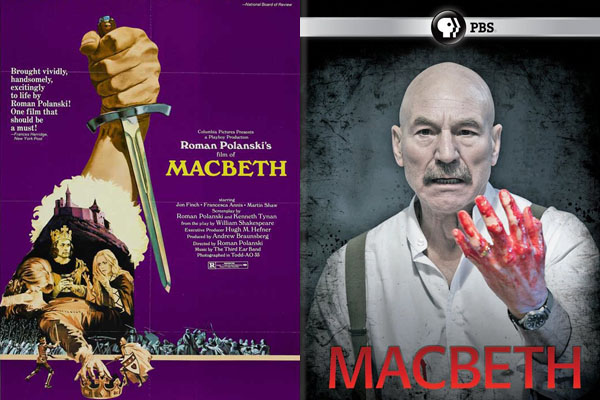
If you’re like me, you’re probably saying Macbeth is a play not a book. But I find that, as it can be read as a book and is a large part of the curriculum, that it should count anyway. In case you either haven’t read the play or don’t know what it’s about, a brief outline of this Shakespearean tragedy is that Macbeth is a general who, upon hearing a prophecy from the Wyrd Sisters that he is to be king, and with the goading of his wife, embarks on a bloody campaign that gets him the crown at the cost of several lives. Along with Shakespeare’s other famous plays, there have been multiple film adaptations, but I’m primarily going to focus on two. First there’s the 1971 version, as it’s a more well known adaption and also because it’s highly different from the play. The other is a more recent 2010 version made for television which, English and Shakespeare teacher Thomas Fuller tells me, is the only good film adaption that he’s seen.
The 2010 version, directed by Rupert Goold and starring Patrick Stewart as Macbeth (yes, Prof. X from X-Men is now playing a serial killer) and Kate Fleetwood as his wife. Unlike the 1971 version, this version is a modern day adaption that also evokes the atmosphere of the Soviet Union under Joseph Stalin. Normally I would go into detail about what I liked and disliked about the film, but I really don’t have any complaints about this one. The Wyrd Sisters are increasingly frightening from how they appear and disappear when you least expect them, despite their really simple costumes. All the other acting is phenomenal, especially Fleetwood’s performance of the sleepwalking scene.
Speaking with Fuller, he clarified that this version is the best one to use to teach the play as it’s school appropriate and that kids find the post-apocalyptic setting visually interesting.
“It’s all a matter of the director and putting it in a way that fits the audience best. It’s done to fit what’s popular in current culture,” Fuller said.
The 1971 version, is directed by Roman Polanski and stars Jon Finch as Macbeth and Francesca Annis as his wife. For the most part, I really enjoyed this adaption except for two things. First, there were the Wyrd Sisters, who are supposed to appear and disappear at random. That does not happen and it frankly left me highly disappointed. Then, there was the sleepwalking scene. The entire time I thought of the 2010 version where it utilizes the use of it being a film to fully show Lady Macbeth’s haunted expression. That’s another thing that doesn’t happen and once again, is highly disappointing. On the other hand what I enjoyed about this film was once again the acting. Through Finch’s performance as Macbeth, I was able to see the character gradually lose touch with reality, especially towards the end. Also, some of the soliloquies were done as inner monologues, which I personally found interesting to see.
“For it’s time it was a good production and I look at it this way, Polanski took it this way and Stewart took it in another,” Fuller said.
Also, besides being more violent in nature, this version differs further from the source material as it takes the relatively unimportant character of Ross ( played here by John Stride) and turns him into a highly immoral and opportunistic henchmen of Macbeth. Personally, I found this interesting as Polanski does this without giving him any new dialogue or putting him anywhere that Shakespeare does not put him, with the exception being this one scene where he becomes the third murderer. Of course, I also agree with Fuller’s opinion that it doesn’t work as Macbeth need to feel isolated, without anyone having any knowledge of what he’s done.
In conclusion, I would recommend watching both versions, but if you want something that’s a bit more in keeping with the play, rent the 2010 version.
From Book to Film: Divergent
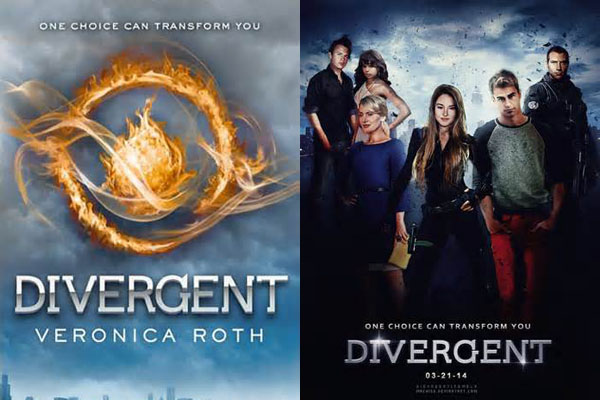
While Divergent is not actually taught as part of the RB curriculum, the novel recently released on the big screen has been part of RB’s now-discontinued summer reading program.
The plot of Divergent by Veronica Roth is best described as The Giver by Lois Lowry meets The Hunger Games by Suzanne Collins. And it’s also set in one of the greatest cities of all time: Chicago. To be more specific the plot follows a girl named Beatrice “Tris” Prior who lives in a dystopian world where you get sorted into separate categories based on who you are. Categories include Abnegation for the selfless, Amity for the peaceful, Candor for the honest, Dauntless for the brave, and Erudite for the knowledgeable. Of course, when Tris gets sorted, she finds she does not fit any of the categories. She is “divergent,” which leads to a whole series of problems.
I saw this film the first Monday of Spring Break, and to my greatest surprise, I found that the theater was mostly empty, with only fifteen to twenty people there which surprised me given the popularity of the novels. The film only came out three days ago.
I must say I really liked both film and book. Granted I liked The Hunger Games more, which I’ll just mention because that series comes up a lot in this review, but still this was a really good movie. Shailene Woodley (who will also be appearing as Hazel in the film adaption of The Fault in Our Stars) was excellent as the hero, as was Theo James as the dreamy love interest. I also found it interesting how Miles Teller was cast completely against type here. Instead of a fun loving hero, here he’s one of the villains, and he’s good at it. You hate the guy right off the bat. Also of note, Kate Winslet (having forgone her trademark of appearing naked in all of her films for a PG-13 rating since she’s not as young as she used to be) is also really good as another of the story’s villains.
RB Department Chair of Library and Instructional Technology Bridget Wilmot said, “[The dystopian genre] is the most popular genre right now. When The Hunger Games was so successful, authors started writing like that. Now, Divergent has become The Hunger Games.”
Divergent was published April 25, 2011, just three years ago. In the grand scheme of publishing, that’s actually a very short time. This only goes to show how popular Roth’s books have become.
Still, Wilmot is realistic about the series’ long-term appeal.
“It’ll be popular until the movies come out because they create buzz that’ll get kids to read the books. But, by the time the movies are out, some new series like Twilight or The Hunger Games will come out,” she said.
From Book to Film: Schindler’s List
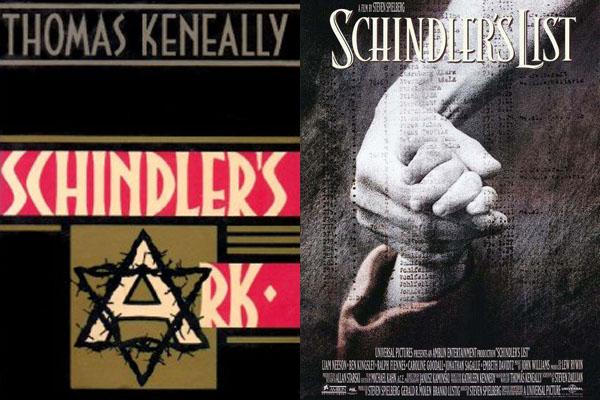
Schindler’s Ark (released in America as Schindler’s List) by Thomas Keneally tells a powerful and real life story about good vs. evil. The story is set in Poland during WWII and follows the life of Oskar Schindler, a womanizing war profiteer and prison camp director who ends up saving over a thousands lives. The novel was adapted by Steven Spielberg (of Jaws, Close Encounters of the Third Kind, Raiders of the Lost Ark, E.T., Jurassic Park, Saving Private Ryan, War Horse, and Lincoln fame) into a film that not only won seven Oscars, including best picture and best director, but is also part of the Western Civ Curriculum.
When I saw this in social studies last year it quickly became one of the most amazing movies I had ever seen. This movie must have been over two hours long but towards the end I still wanted to know more, what happened after this. Along with the directing the cast is amazing. Among the 126 speaking parts, highlights include Liam Neeson as Schindler, Ralph Fiennes as Untersturmführer Amon Goeth ( who you may recognize in a more recent action-fantasy series as another sociopathic xenophobe) and Sir Ben Kingsley as Schindler’s Jewish accountant. A funny thing that I learned about the casting is that Neeson looks nothing like Schindler whereupon Fiennes is the spitting image of Goeth. From reading the novel I’ve found that the film dramatized some scenes while also shortening and or dramatizing some instances but this is still a great movie. People should still bear in mind that the film is overall true to the heart of the story, which I think is the more important thing. Also if the film included everything that was in the novel it would probably be five hours long and plus if you’re not watching a documentary, what film that’s based on a true story is 100% historically accurate.
I decided to interview Western Civ teacher Erin Cunningham about why teachers would specifically choose to show this film.
“It’s important that students see it as it makes the Holocaust more real. How families were torn apart and how awful it was,” she said. Of course to which my follow-up question was how she felt about how there were some historical inaccuracies.
“Some fictionalization but it’s based in fact. There was a man named Oskar Schindler, he had a list, there was a man named Amon Goeth who was quite horrible…but even as fiction it’s important as the drama is important to draw people in,” she said.
As this is part of the curriculum there’s a good chance that you are going to see this movie, but if for some reason you don’t, I would highly recommend renting it. Not only is it an amazing movie but I think that it’s also important just to know the extent of what happened during this time period, even if there are some fictionalization.
From Book to Film: The Great Gatsby
F. Scott Fitzgerald’s The Great Gatsby is a novel that everyone seems to love. It is considered a classic. It is taught at schools all over the country, including RB, of course. Last year it was the prom theme and this year it is going to be performed for the fall play.
Set against the backdrop of the Roaring Twenties, the novel is narrated by Nick Carraway, who rents a small house next to the outlandish mansion of the mysterious Jay Gatsby. What he soon discovers is that not everything is as it seems.
Like several other American classics, there have been several film versions. So I decided to look at the only one besides the Baz Luhrmann version to win an Academy Award: the 1974 version, with a script written Francis Ford Coppola, of The Godfather Trilogy and Apocalypse Now fame. For the review of the 2013 version starring Leonardo DiCaprio, go here.
To quote the late, great film critic Roger Ebert, “It would take about the same time to read Fitzgerald’s novel as to view this movie — and that’s what I’d recommend.” This movie is terrible and it utterly pales in comparison to the novel. It’s unbelievably slow moving and boring.
The acting is atrocious. There’s no chemistry between anyone, which is probably the one thing you need in a love story. There’s a few good scenes here and there, but there so few and far between that it’s not enough to save the movie.
And Robert Redford is the Great Gatsby? They don’t even stage his introduction like they’re supposed to. Leaving no reason for Nick (pre-Law & Order Sam Waterston) to even become friends with and like Gatsby in the first place.
The movie did win an Academy Award for Best Costume Design (Theoni V. Aldredge) and Best Music (Nelson Riddle), but I didn’t think those were anything special either. Except the music. Possible.
One of the universe’s biggest ironies is that more often than not, great books are made into not-so-great movies. If you don’t believe me, believe Roger Ebert. Why exactly is this novel so popular? I decided to speak to AP Lit teacher Lawrence Forberg and see if he noticed increased interest in Gatsby lately.
“The renewed interest in the novel is in response to the latest version of the movie,” Forberg said, “the use of contemporary music and the flashy and stylized shots and sets has captured the imagination of a new audience. I hope it will influence people to read the novel. It certainly boosted sales, but buying the book does not always means people are reading.”
But at RB, people are reading. It’s a book about a incredibly wealthy guy in the twenties. On the surface it doesn’t seem like teenagers would easily relate to it or be interested.
“Teenagers might find the pursuit of a dream appealing,” Forberg said, “ also, many people want something better or see themselves as something different. James Gatz saw himself as someone born for bigger and greater things and that is why he ‘gave birth’ to Jay Gatsby.”
To conclude, I asked if Forberg though it was possible to make a live-action retelling. Given that the beauty of Gatsby is the imagery brought about by it’s beautiful prose
What he said was that there are ways in order to translate that to a different form of media. For example, in the 2013 version, Forberg felt the inclusion of Nick’s voice over helped keep the language in the forefront. “Though [Luhrmann] had to make a major change in the novel. Nick is not a recovering alcoholic in the novel and is not writing a journal to share with his doctor,” Forberg said, “this is a bastardization of the text, but it was used to keep the poetic language in the movie.”
So, if done carefully, it is possible to make a live-action film retelling of the novel. Time will only tell if this applies to a stage version. Times for the fall play are Nov. 12th, 13th, and 14th. More information to come later.
